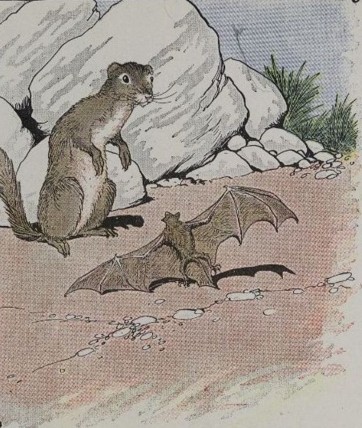PART A_1
Let’s learn vocabulary. Listen and repeat the words and the sentences with your tutor.
PART A_2
| 1. nest | /nest/ |
| -a structure built by birds or insects to leave their eggs in to develop, and by some other animals to give birth or live in | |
| The bird built its nest inside a tree hollow. | |
| 2. foolish | /FOO-lish/ |
| -unwise, stupid, or not showing good judgment | |
| It was a foolish thing to say. | |
| 3. happen | /HAP-uhn/ |
| -to do or be by chance | |
| Julia happens to be my friend, so I’ll introduce you to her. | |
| 4. claw | /klaw/ |
| -a sharp, curved nail at the end of an animal’s foot | |
| The cats sharpened their claws on the tree’s trunk. | |
| 5. motto | /MOT-oh/ |
| -a short sentence or phrase that expresses a belief or purpose | |
| The fandom lives by the motto “Teamwork makes the dream work”. |
PART B_1
Let’s read the story. Please read them aloud, and I will check your pronunciation and intonation.
PART B_2
The Bat and the Weasels

A Bat blundered into the nest of a Weasel, who ran up to catch and eat him. The Bat begged for his life, but the Weasel would not listen.
“You are a Mouse,” he said, “and I am a sworn enemy of Mice. Every Mouse I catch, I am going to eat!”
“But I am not a Mouse!” cried the Bat. “Look at my wings. Can Mice fly? Why, I am only a Bird! Please let me go!”
The Weasel had to admit that the Bat was not a Mouse, so he let him go. But a few days later, the foolish Bat went blindly into the nest of another Weasel. This Weasel happened to be a bitter enemy of Birds, and he soon had the Bat under his claws, ready to eat him.
“You are a Bird,” he said, “and I am going to eat you!”
“What,” cried the Bat, “I, a Bird! Why, all Birds have feathers! I am nothing but a Mouse. ‘Down with all Cats,’ is my motto!”
And so the Bat escaped with his life a second time.
Set your sails with the wind.
PART C_1
Let’s answer comprehension questions. Please answer them based on the story.
PART C_2
| 1. | How did the Bat convince the Weasel to free him? |
| 2. | What happened a few days after his unfortunate encounter with the Weasel? |
| 3. | How did the Bat convince the other Weasel not to eat him? |
PART D_1
Let’s discuss the story. Please answer the questions below and express your opinions.
PART D_2
| 1. | How would you describe the Bat in the story? |
| 2. | How does the Bat make the best out of a bad situation? |
| 3. | If the Bat encountered another predator in the story, do you think he would still be alive? Explain your answer. |
| 4. | Explain the moral of the story: “Set your sails with the wind.” |
| 5. | Have you had an experience similar to the fable’s lesson? Tell me more about it. |
REVIEW AND FEEDBACK
Now, let us review the things that you learned in this lesson.
ではこのレッスンで学んだことを振り返りましょう。
(Please give a short feedback on how your student did on your class.)
| Grammar 文法 |
Pronunciation 発音 | Vocabulary 単語 |
Comprehension 理解 |
|
|---|---|---|---|---|
 GOOD GOOD |
文法の誤りはほとんどなく、完全な文章で話すことができる | ほとんどの単語をはっきりと正しく発音することができる | 習った表現を適切に使うことができる | 文章を理解し、質問に正しく答えることができる |
 FAIR |
文法の誤りはあるが、完全な文章で話すことができる | 発音の練習が必要な言葉がいくつかある | たまにミスはあるが、習った表現を適切に使うことができる | 文章を完全に理解するのは難しく、質問に正しく答えられないときもある |
 POOR |
文章で話すのは難しく、単語だけで話すことができる | 発音の練習が必要である | 習った単語と表現を少しだけ使うことができる | 文章を理解するのは難しく、質問に答えるのは難しい |
Parts of this lesson material are based on:
An eBook from The Project Gutenberg.
This eBook is for the use of anyone anywhere at no cost and with almost no restrictions whatsoever. You may copy it, give it away or re-use it under the terms of the Project Gutenberg License included with this eBook or online at www.gutenberg.org
An eBook from The Project Gutenberg.
This eBook is for the use of anyone anywhere at no cost and with almost no restrictions whatsoever. You may copy it, give it away or re-use it under the terms of the Project Gutenberg License included with this eBook or online at www.gutenberg.org